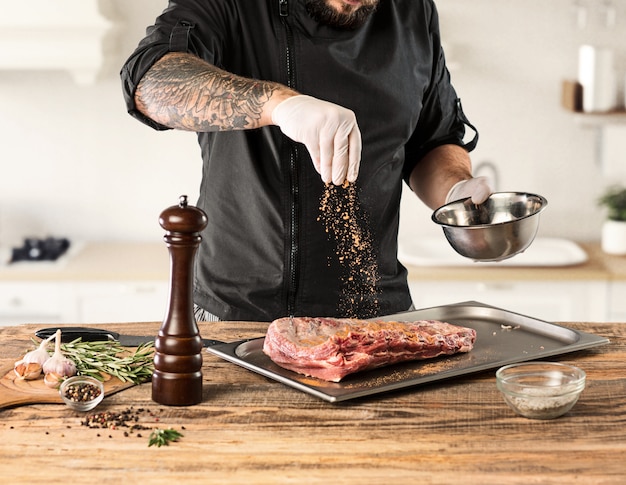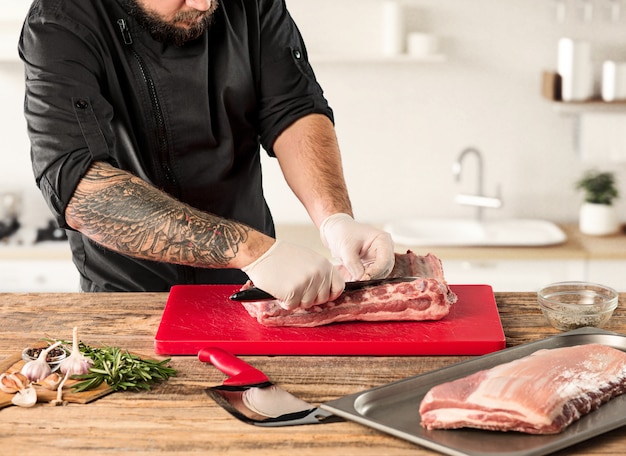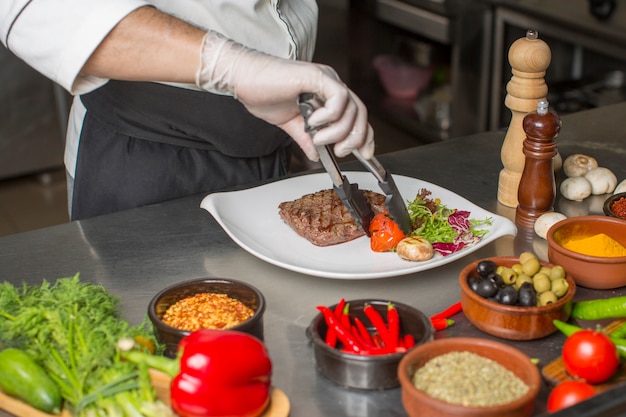Let's face it, there's nothing quite like a perfectly cooked roast beef. The juicy, tender meat, the gloriously crispy edges, that rich, savory aroma filling your kitchen... it's a culinary masterpiece! But we've all been there, staring at that hunk of beef in the oven, wondering if we're about to create a dry, disappointing disaster. Don't worry, my fellow foodies! I'm here to guide you through the process, sharing my hard-earned knowledge and turning you into a roast beef pro.
(Part 1) The Prime Cut: Choosing the Right Beef

It all starts with the star of the show – the beef itself. Don't just grab the first cut you see. choosing the right cut is like choosing the right ingredients for any dish; it's crucial to success. Understanding the different cuts and their strengths will lead you to a delicious outcome.
The Beefy Lowdown
- rib roast: This is the classic choice for a show-stopping roast beef. The rib roast, also called a prime rib, is a big, beautiful cut that comes from the rib section of the cow. Think of it as the Rolls Royce of roasts. It's full of rich, marbled fat that melts in your mouth, creating a symphony of flavor. It's definitely a splurge, but it's worth it for a special occasion.
- sirloin roast: A more budget-friendly option, the sirloin roast still delivers a punch of flavor. It's a leaner cut, so it might be slightly drier than the rib roast, but it's perfect for slicing and serving. The sirloin is a great choice for a casual gathering or a weekday dinner.
- top round roast: This cut comes from the back of the cow and is leaner than both the rib and sirloin. It's a great choice for roasting and slicing for sandwiches, as it holds its shape well. It's a bit tougher than other cuts, so it needs a longer cooking time to become tender.
- chuck roast: This cut comes from the shoulder of the cow and is known for its intense flavor. It has a lot of connective tissue, which breaks down during cooking, yielding a melt-in-your-mouth result. Chuck roast is perfect for slow cooking and shredding for sandwiches, tacos, or hearty stews.
My personal favourite? Rib roast, hands down. It's all about that luscious marbling and the sheer joy of cutting into a perfectly cooked piece. But, honestly, any of these cuts can be delicious when cooked correctly. It's about finding the cut that suits your taste and budget.
(Part 2) Prep Like a Pro: Getting Ready for Roast Beef Glory

You've got your chosen cut of beef, now it's time to get down to business with the prep. It's not rocket science, but it's essential for ensuring that roast beef perfection.
The Salt Whisperer
Salt is your best friend in this process. It's not just about seasoning; it actually helps to break down the proteins in the beef, making it more tender and flavorful. A technique called "salt aging" involves generously salting the roast a day or two before cooking. The salt draws out moisture, then reabsorbs it, resulting in a more tender and flavorful roast. If you're short on time, a good sprinkle a couple of hours before cooking will do the trick. But make sure to dry the surface of the meat with paper towels before salting to prevent the salt from drawing out too much moisture.
Don't be shy with the salt; a generous amount is key! I'm talking about a thick, even layer that covers the entire surface of the roast. It may seem like a lot, but trust me, it's the secret to a truly delicious roast.
The Herb Garden
Herbs add a touch of magic to any roast, amplifying the flavors of the meat. I love to use a mix of rosemary, thyme, and garlic, but get creative! Experiment with other herbs like sage, oregano, or even a hint of lavender. You can use fresh or dried herbs, depending on your preference. I usually rub the herbs all over the beef, ensuring I get into all those nooks and crannies. The more herb contact, the more flavour infusion!
(Part 3) Temperature Takes the Lead: Cooking to Perfection

Now comes the moment of truth – cooking the roast. It's not just about sticking it in the oven and hoping for the best. You need to get the temperature right, and that involves a bit of strategic thinking.
Oven Love: The Right Temperature
First things first: preheat your oven. A hot oven is key to getting that beautiful, crispy crust on the roast. I usually preheat it to 450°F (232°C), but remember, this isn't the cooking temperature. It's for the initial sear, which locks in the juices and creates that irresistible crust. After about 15-20 minutes, you'll reduce the temperature to 325°F (163°C) to slow cook the meat, ensuring it's tender and juicy. This slow cooking allows the heat to penetrate the meat evenly, yielding a melt-in-your-mouth experience.
Timing is Everything: How Long to Cook
Cooking time depends on the size and thickness of your roast, but here's a general guideline:
- Rib Roast: 15-20 minutes per pound for rare, 20-25 minutes per pound for medium-rare, 25-30 minutes per pound for medium.
- Sirloin Roast: 15-20 minutes per pound for rare, 20-25 minutes per pound for medium-rare, 25-30 minutes per pound for medium.
- Top Round Roast: 20-25 minutes per pound for medium-rare, 25-30 minutes per pound for medium, 30-35 minutes per pound for well-done.
- Chuck Roast: 30-40 minutes per pound for medium-rare, 40-50 minutes per pound for medium, 50-60 minutes per pound for well-done.
But hey, a trusty meat thermometer is your best friend here. Aim for the following temperatures:
| Doneness | internal temperature |
|---|---|
| Rare | 125°F (52°C) |
| Medium-Rare | 130°F (54°C) |
| Medium | 140°F (60°C) |
| Medium-Well | 150°F (66°C) |
| Well-Done | 160°F (71°C) |
For an extra layer of deliciousness, consider searing the roast before cooking. This is where that initial high heat comes in handy. Heat a skillet over high heat and sear the roast on all sides for a few minutes. This will create a beautiful, crispy crust and seal in the juices. It's a simple step, but it makes a big difference in flavor and presentation.
(Part 4) The Rest Is Best: Let the Roast Relax
Once your roast is cooked to perfection, don't rush to slice it open. Give it some time to rest! This allows the juices to redistribute throughout the meat, ensuring that your roast is beautifully juicy and flavorful. I usually let it rest for at least 15 minutes, covered in foil, before carving. The longer you let it rest, the more tender and juicy it will be. It's a bit of a waiting game, but trust me, it's worth it!
(Part 5) Carving Masterclass: How to Cut Like a Pro
The moment of truth has arrived – it’s time to carve your masterpiece. This is a bit of a performance art, but don’t fret, I’ve got you covered.
Slice and Dice
Using a sharp carving knife, start by cutting slices across the grain. This will make the meat more tender and easier to chew. Aim for thin slices, about 1/4 inch thick. Make sure to cut through the fat, as it adds a lot of flavor. You can also use a carving fork to hold the roast in place while you carve, ensuring a steady hand and precise cuts.
(Part 6) Sides that Shine: The perfect roast beef Companions
No roast beef is complete without some amazing sides. You want dishes that complement the richness and savoryness of the meat, creating a symphony of flavors that will tantalize your taste buds. Here are some of my go-to sides:
- Yorkshire Pudding: A classic British favourite! It's light and fluffy, with a crispy exterior, and soaks up all those delicious roast juices, making it the perfect companion for the rich and savory roast beef. You can’t go wrong with Yorkshire pudding.
- Roasted Vegetables: Think roasted potatoes, carrots, Brussels sprouts, asparagus, you name it. Roast them with a bit of olive oil, salt, and pepper, and you've got a delicious and simple side. The roasting process enhances the natural sweetness of the vegetables, creating a perfect contrast to the rich flavors of the beef.
- mashed potatoes: Creamy, comforting, and a perfect pairing for roast beef. You can make them classic or add some flavor with herbs, cheese, or even bacon. The creamy texture of the mashed potatoes complements the juicy beef beautifully.
- green beans: Steamed or sautéed, green beans add a bit of freshness to the meal, balancing the heavier flavors of the roast.
- Gravy: No roast beef is complete without gravy. It's the perfect way to add even more flavor to your meal, and it adds a touch of elegance. You can make your own gravy from the pan drippings, or you can use a store-bought version.
(Part 7) Leftover Love: Turning Your Roast into a Feast
So, you’ve had your magnificent roast beef feast, but you’ve got some leftovers. Don’t fret, those leftovers are about to become even more delicious.
Second Act: Leftover Transformations
- roast beef sandwiches: The classic! Pile high some roast beef slices on a crusty roll, add some horseradish sauce, and you’ve got a sandwich that will rock your world.
- Roast Beef Salad: A lighter option, but still packed with flavour. Toss some roast beef slices with greens, tomatoes, onions, and a tangy vinaigrette.
- Beef Hash: A hearty and delicious way to use up leftover beef. Dice the beef and potatoes, fry them up with onions and spices, and you’ve got a satisfying meal.
- Beef Soup: A comforting and flavorful soup. Use the leftover beef and bones to make a rich and flavorful broth, then add in your favorite vegetables.
(Part 8) Beyond the Roast: Roast Beef Mastery in the Making
You’ve mastered the art of roast beef, but your culinary journey doesn’t stop here. There’s always something new to learn, a technique to refine, a flavour to experiment with.
The Roast Beef Renaissance
- Different Cuts: Branch out and experiment with different cuts of beef. Try a chuck roast for a slow-cooked masterpiece, or a flank steak for a flavorful stir-fry.
- Marinades: Take your roast beef to another level with a marinade. Soy sauce, ginger, garlic, and honey make a fantastic combination. You can also experiment with herbs, citrus, or even wine.
- Cooking Methods: Go beyond the oven and explore other cooking methods. Try grilling, smoking, or even using a sous vide machine for a perfectly cooked roast.
Remember, cooking is a journey, a constant exploration of flavors and techniques. So keep experimenting, keep learning, and most importantly, keep enjoying the journey!
FAQs
1. What’s the best way to store leftover roast beef?
To keep your leftover roast beef fresh and flavorful, wrap it tightly in plastic wrap or aluminum foil. Then store it in the refrigerator for up to 4 days. You can also freeze leftover roast beef for up to 3 months. When freezing, wrap the beef tightly in plastic wrap and then in aluminum foil. This helps prevent freezer burn and preserves the deliciousness of your roast.
2. How do I tell if my roast beef is done?
The best way to tell if your roast beef is done is to use a meat thermometer. Insert the thermometer into the thickest part of the roast, making sure it doesn’t touch any bone. Check the internal temperature against the table provided in (Part 3) to ensure it’s cooked to your desired doneness.
3. What can I do if my roast beef is a bit dry?
Don’t worry, a little dryness can be easily fixed! You can add some moisture to your roast by slicing it thinly and then adding it to a sauce or gravy. Or, you can try making a roast beef sandwich with some flavorful toppings like horseradish sauce or mustard. The trick is to add a bit of richness and moisture to compensate.
4. Can I cook roast beef in a slow cooker?
Yes, you can absolutely cook roast beef in a slow cooker. It’s a great way to get a tender and flavorful roast. Just season the roast with your favorite herbs and spices, then place it in the slow cooker. Add a cup of liquid, like beef broth or water, to the bottom of the slow cooker, and cook on low for 6-8 hours or on high for 3-4 hours. This method is perfect for those busy days when you need a hands-off approach.
5. What are the best wines to pair with roast beef?
There are many wines that pair well with roast beef. A full-bodied red wine, like Cabernet Sauvignon or Merlot, is a classic choice. You can also try a Zinfandel or a Shiraz. For a lighter option, try a Pinot Noir or a Beaujolais. Experiment with different wines to find your favorite pairing! The key is to find a wine with enough tannins and acidity to complement the richness of the roast beef.
Everyone is watching

Prime Rib Roast Cooking Time Chart: Per Pound Guide
Cooking TipsPrime rib roast. Just the name conjures images of lavish dinners, crackling fires, and hearty laughter. It’s ...

How Long to Bake Potatoes in the Oven (Perfect Every Time)
Cooking TipsBaked potatoes are a staple in my kitchen. They're incredibly versatile, delicious, and surprisingly easy to m...

Perfect Rice Every Time: The Ultimate Guide to Cooking Rice
Cooking TipsAs a self-proclaimed foodie, I've always been a bit obsessed with rice. It's the foundation of countless cuisi...

The Ultimate Guide to Cooking Asparagus: Tips, Techniques, and Recipes
Cooking TipsAsparagus. The mere mention of this spring delicacy conjures up images of vibrant green spears, crisp and burs...

Ultimate Guide to Cooking the Perfect Thanksgiving Turkey
Cooking TipsThanksgiving. Just the word conjures up images of overflowing tables laden with delicious food, the scent of r...
